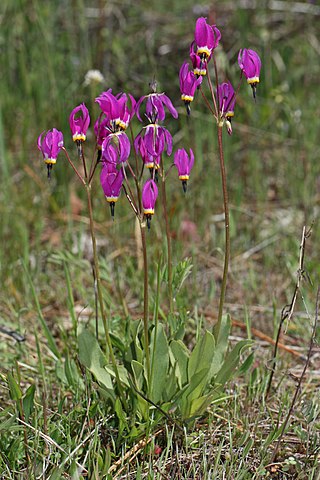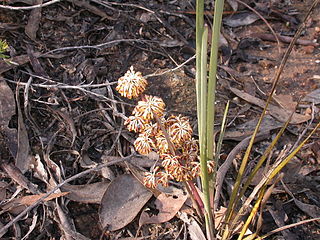
Ficaria verna, commonly known as lesser celandine or pilewort, is a low-growing, hairless perennial flowering plant in the buttercup family Ranunculaceae native to Europe and Western Asia. It has fleshy dark green, heart-shaped leaves and distinctive flowers with bright yellow, glossy petals. It is now introduced in North America, where it is known by the common name fig buttercup and considered an invasive species. The plant is poisonous if ingested raw and potentially fatal to grazing animals and livestock such as horses, cattle, and sheep. For these reasons, several US states have banned the plant or listed it as a noxious weed. It prefers bare, damp ground and is considered by horticulturalists in the United Kingdom as a persistent garden weed; nevertheless, many specialist plantsmen, nursery owners and discerning gardeners in the UK and Europe collect selected cultivars of the plant, including bronze-leaved and double-flowered ones. Emerging in late winter with flowers appearing late February through May in the UK, its appearance across the landscape is regarded by many as a harbinger of spring.

Ansellia is considered a monotypic genus of orchid, with only one species, Ansellia africana, commonly known as African ansellia or leopard orchid, however, it may in fact be a complex group of species which share common floral structure and growth habit.

Paeonia brownii is a low to medium height, herbaceous perennial flowering plant in the family Paeoniaceae. It has compound, steely-gray, somewhat fleshy leaves and small drooping maroon flowers. Its vernacular name is Brown's peony, native peony or western peony. It is native to the western United States and usually grows at altitude, often as undergrowth in part-shade. The fleshy roots store food to carry the plant through the dry summers and produce new leaves and flowers the following spring.

Bambusa vulgaris, common bamboo, is an open-clump type bamboo species. It is native to Indochina and to the province of Yunnan in southern China, but it has been widely cultivated in many other places and has become naturalized in several regions. Among bamboo species, it is one of the largest and most easily recognized.

Hakonechloa is a genus of bunchgrass in the tribe Molinieae of the grass family, Poaceae, native to eastern Asia.

Festuca glauca, commonly known as blue fescue, is a species of flowering plant in the grass family, Poaceae. It is a commonly cultivated evergreen or semi-evergreen herbaceous perennial.

Dietes bicolor, the African iris, fortnight lily or yellow wild iris, is a clump-forming rhizomatous perennial plant with long sword-like evergreen pale green leaves, growing from multiple fans at the base of the clump. This species belongs to the iris family Iridaceae. It can form large clumps if left undisturbed for years. It is commonly cultivated in its native South Africa, where it is often used in public gardens, beautification of commercial premises and along roadsides. It is also cultivated in mild temperate zones elsewhere.

Paeonia ludlowii, is a deciduous shrub of medium height, belonging to the tree peony section Moutan of the genus Paeonia, and endemic to southeast Tibet. In Tibet it is known as ≠'lumaidao' meaning "God's flower". The vernacular name in Chinese is 大花黄牡丹 meaning "big yellow-flowered peony". In English it is sometimes called Tibetan tree peony or Ludlow's tree peony. It has pure yellow, slightly nodding, bowl-shaped flowers, and large, twice compounded, light green leaves.

Vigna marina is a prostrate, creeping vine and a perennial plant. Also known as the beach pea, nanea, and notched cowpea, it is a species of legume in the family Fabaceae.

Hesperostipa spartea, formerly Stipa spartea, is a species of grass known by the common names porcupine grass, western porcupine grass, short-awn porcupine grass, porcupine needlegrass, and big needlegrass. It is native to North America, where it is widespread from British Columbia to Ontario in Canada and through the central and Great Lakes regions of the United States. It is a bunchgrass species in the genus Hesperostipa.

Primula poetica, synonym Dodecatheon poeticum, is commonly known as the poet's shooting star or the narcissus shooting star. P. poetica is a species of the genus Primula placed in section Dodecatheon. It is native to the states of Oregon and Washington in western North America. The section contains herbaceous flowering plants and is also a part of the primrose family Primulaceae. This plant has basal clumps of leaves and drooping flowers that occur at the apex of tall stems that rise from where the leaves join.

Muhlenbergia capillaris, commonly known as the hairawn muhly, is a perennial sedge-like plant that grows to be about 30–90 cm (0.98–2.95 ft) tall and 60–90 cm (2.0–3.0 ft) wide. The plant includes a double layer; green, leaf-like structures surround the understory, and purple-pink flowers outgrow them from the bottom up. The plant is a warm-season grass, meaning that leaves begin growth in the summer. During the summer, the leaves stay green, but they morph during the fall to produce a more copper color. The seasonal changes also include the flowers, as they grow out during the fall and stay healthy till the end of autumn. The muhly grows along the border of roads and on plain prairies. The grass clumps into herds, causing bush-like establishments in the area the hairawn muhly inhabits. The flowers are very feathery and add a cloudlike appearance to the top of the grass. It is native to eastern North America and can be used for a multitude of purposes, including ornamental gardening and farming. It was voted 2012 plant of the year by the Garden Club of America.

Olearia paniculata, commonly called akiraho, is a species of shrub or tree in the family Asteraceae, found only in New Zealand. The tree can grow to 6 metres high, and has yellow-green, oval-shaped leaves, with white undersides and wavy margins.

Aciphylla aurea is a species of Aciphylla, commonly known as golden speargrass or golden Spaniard. Individual plants may be up to 100 cm (39 in) tall, and consist of sharp spiky yellowish-green leaves. A. aurea is found throughout the South Island of New Zealand, usually in mountainous areas but also lower altitude dry well drained grassland sites. It is found at altitudes of 300 to 1,500 m.

Hilaria rigida is a species of clumping perennial grass that is widespread in California deserts. It is commonly known as big galleta. It is a monocot in the Hilaria genus of the grass family (Poaceae).

Iris grant-duffii is a species in the genus Iris. It is also in the subgenus Limniris and in the series Syriacae. It is a rhizomatous perennial, from Lebanon, Israel, Syria, Turkey, Lebanon and Iraq, which has brown bristles/spines on the rhizome, long thin greyish green leaves, short stem carrying a single scented flower in shades of yellow.
Iris longiscapa is a plant species in the genus Iris, it is also in the subgenus Iris and in the section Hexapogon. It is a rhizomatous perennial from the deserts of Kazakhstan, Tajikistan, Turkmenistan and Uzbekistan. They have grass-like leaves and lilac-violet or blue-purple flowers on a tall slender stem.

Tamarix usneoides, locally known as wild tamarisk, is a twiggy shrub or small evergreen tree that grows in saline habitats, semi-deserts and karroid areas in southern Africa. It has a short trunk, thin branches usually growing from ground level, tiny scale-like leaves and spikes of creamy-white flowers.

Lomandra multiflora is a perennial, rhizomatous herb found in Australia. Lomandra multiflora is also commonly known as many-flowered mat rush, mat rush and many flowered mat-lily. Lomandra multiflora is a species that is native to Australia and can be found in New South Wales, Queensland, Victoria, South Australia, Northern Territory of Australia and also in Papua New Guinea. The mat rush is distributed widely in the region and common within its preferred growing conditions. The conservation status of Lomandra multiflora is considered not to be of concern and risk.

Phyla canescens is a species of perennial herbaceous plant in the family Verbenaceae, native to South America. It has been introduced to Australia as an ornamental plant and low-maintenance lawn, but has become naturalised and is considered a serious environmental weed. It is known by several common names including carpet weed, Condamine couch, Condamine curse, fog fruit, frog fruit, hairy fogfruit, lippia, mat grass and no-mow grass.



















